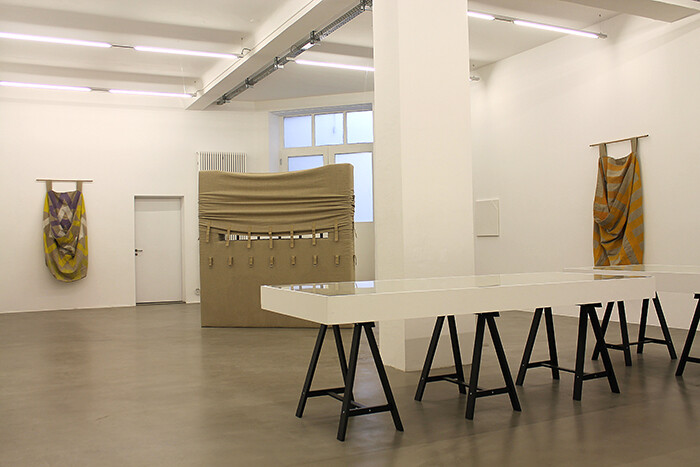Entering ARRATIA BEER from the back doorway, one encounters a sculptural object, covered in raw canvas and impressive in size. Padded and rectangular, it obstructs the view of the entire gallery. Through its center, which is weighed down by an extra layer of fabric, there is a row of buckles, unfastened. 1980/10 (1980) is raw, uninviting, yet captivating at the same time.
For Berlin’s 2014 Gallery Weekend, ARRATIA BEER invited guest curator Eva Wilson to organize a show of work by fairly unknown, and now late, German artist Friedrich Teepe (1929–2012). The show marks Teepe’s first exhibition in 25 years and his first-ever solo show in Berlin. Though shying away from working exclusively as a professional artist, Teepe never stopped producing art alongside his career as a secondary school teacher in Osnabrück. So what could a young curator’s motivation be for interacting and promoting an artist who voluntarily stayed off the art world radar? Might it be an interest in his successful attempt to maintain a sense of autonomy by steering clear of the competitive art market? Or does this curatorial effort count as an exploration of art on the periphery in hopes of canonizing it?
Working with an artist’s oeuvre automatically implies some measure of research, and the investigative element is quite present—two large vitrines display some of Teepe’s notebooks, drawings, pictures, and texts adorned with a feverish amount of scribbles and notes. Next to the upholstered sculptural object are other spatial forms hanging from the wall. Resembling big pouches, 86-4 and 86-5 (both 1971) let the weight of the fabric create movement and heft. From a contemporary perspective, these pieces could easily be misunderstood as “performing entities” because of their suggestive and charged geometrical patterns; however, they successfully maintain their own existence. In addition to 86-4 and 86-5, the show includes monochrome paintings—some smaller, some large, some white, others awash in the natural greyish-brown tones seen throughout the gallery. The canvases are stretched on frames with folded layers—sometimes in a corner, sometimes in the middle of the piece—interrupting their blankness. The works are simple, brutally honest, and speak in an ostensibly formal, direct language that is at times piercingly abstract.
The curator’s selection of this artist is remarkable for several reasons. First of all, Teepe’s artistic position goes against the complete public disclosure exercised by many contemporary artists who “perform” their artistry in a meticulously constructed voice—a voice that serves as an agent of their own work. Secondly, it opposes the contemporary trend of relegating artists’ activities and practices from “object maker” to that of “service provider.” Discussions about contemporary art’s movement away from representation and object production have, in turn, led to the construction and documentation of situations that can be experienced, lived, and interpreted. Teepe deliberately removed himself from this discourse in his artistic approach, and yet, Wilson and ARRATIA BEER’s decision to exhibit his work reinserts this practice directly back into the very framework he sought to avoid. When viewing the show, there is no emphasis on external factors, like the original context in which the work was produced or installed. As such, the viewer’s experience does not necessarily reach beyond the engagement with artworks as autonomous objects; Teepe’s work exists within its own reality without reference to an actuality beyond it.
Although the artist’s oeuvre could easily be folded into this minimalistic game, Teepe’s small interventions with the folds, his spare use of color, and his use of fabric introduce a subtlety to his work. These elements suppress any potential claims on monumentality: where one expects art, it has been negated. He has succeeded in creating work that is, in a sense, invisible despite being in full view. Through a game of mimicry and folds, he produces art where you least expect it—in the spaces between voids. And this, for Teepe, seems to be the canvas upon which meaning is produced.








